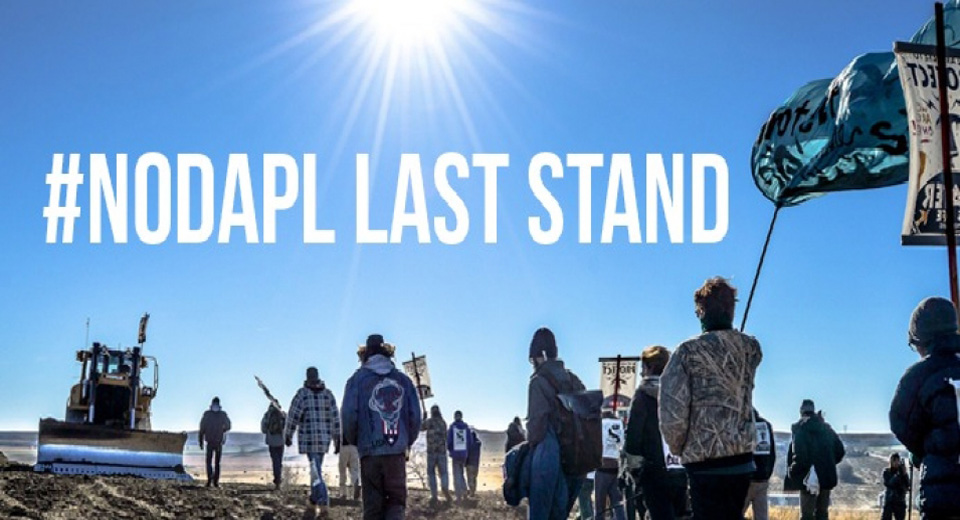
In a worldwide demand for action, the indigenous people’s activist coalition at Standing Rock in North Dakota has released a statement calling on people to take ‘the last stand.’ Water protectors around the globe are gearing up to square off in one final battle against the Dakota Access Pipeline. For almost a year, the ongoing fight against the oil pipeline infrastructure by indigenous communities and allies have led to repeated confrontations with police forces. Opposing sides have clashed on several occasions, leading to arrests, raids, and permanent injuries for individuals who have fought on the front lines.
Despite much of the adversity that has accompanied the struggle, the movement to “kill the black snake” brought together people from all walks of life, spawning the launch of the Oceti Sakowin camp, Sacred Stone, and other similar popup settlements aimed at halting the construction of the pipeline.
On February 7th, about three weeks after the new Republican administration took power in Washington DC, the Department of the Army announced it would grant the final easement permit needed to complete the Dakota Access Pipeline. Energy Transfers Partners now has federal authorization to begin drilling under the Missouri River/Lake Oahe, without a full environmental impact statement. The drilling is estimated to take approximately 83 days to complete, and will require the installation of a “30-inch-diameter light crude oil pipeline under federal lands managed by the corps at Oahe Reservoir.” The Standing Rock Sioux Tribe and Cheyenne River Sioux Tribe are expected to sue and are demanding a temporary restraining order to halt construction while the permissibility of the decision is reviewed in court. This legal recourse does not, however, hamper the construction process, and will likely take time to process. In the meantime, drone footage of the construction site has indicated that the drilling has already begun.
For many water protectors, this was the last shot at stopping the Dakota Access Pipeline. Much has been sacrificed since the first tipis were set up in April 2016. No one then could imagine the wave of momentum that would arise out of the #NoDAPL movement, raising the chorus of “Water is life!”
For others, however, the fight is far from finished. Dallas Goldtooth, an organizer at Indigenous Environmental Network and leading voice in the Standing Rock movement said in a Facebook livestream that he wanted people to continue to disrupt business as usual. “This isn’t just about Standing Rock, this isn’t just about the pipeline, this part of the greater struggle that we are in right now.” Goldtooth has said the time is now for people to hold public demonstrations at city halls, federal buildings, and the Army Corps of Engineers’ offices all around the nation. “This movement to resist, to push back, and to rise up together, unified, in a call to action to build a better world.”
Even with circumstances growing seemingly bleaker for the possibility of stopping the Dakota Access Pipeline, activists have scored some wins. Seattle announced Wednesday that it was severing ties with Wells Fargo in protest of Dakota Access pipeline, making the $3 billion divestment the largest yet. According to an NPR report, the City Council in Davis, California announced a similar decision over the pipeline just hours after Seattle announced its plans to break ties with the international banking and financial services company. The Davis city council “voted unanimously to find a new bank to handle $124 million in accounts by the end of 2017,” taking a political stance that is undoubtedly influenced by the mass protests that have reached the ears of even the highest corporate echelons.
Other activists also say they are not yet ready to throw in the towel. “We have to continue the push for divestment on these projects,” says Chicago activist Andrea Perkins, member of the Chinook and Haida Nations. “At the same time we have to continue the education of the public on why these pipelines are harmful.” In the past local grassroots led organizations, such as Bold Louisiana and Mississippi Stand, have been successful at delaying or stopping dozens of fossil fuel projects, and the successes of these groups may encourage people to continue the resistance in the face of administrative challenges.
As the end of the Dakota Access Pipeline battle draws near, uncertainty about the next steps in the opposition remain. Native communities are now holding discussions to strategize for the future of this newfound mobilization. Several indigenous leaders are preparing to enter a new phase in organizing around pipeline resistance and resistance against the fossil fuel industry. Regardless, it is clear that the campaign against oil pipelines will continue. Even before the election results were finalized, Standing Rock served as a template for resistance under the Trump administration– one rooted in spirituality and deep purpose. “The pipelines hurt more than just the land and water, they are hurting our communities,” said Perkins. “We are connected to the issues at a deeper level than just simple environmentalism. That’s why we have to continue to resist.”










